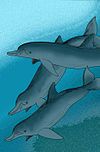IntroductionSelected article on the Neogene world and its legacies
The geology of Scotland is unusually varied for a country of its size, with a large number of differing geological features. There are three main geographical sub-divisions: the Highlands and Islands is a diverse area which lies to the north and west of the Highland Boundary Fault; the Central Lowlands is a rift valley mainly comprising Paleozoic formations; and the Southern Uplands, which lie south of the Southern Uplands Fault, are largely composed of Silurian deposits.
The existing bedrock includes very ancient Archean gneiss, metamorphic beds interspersed with granite intrusions created during the Caledonian mountain building period (the Caledonian orogeny), commercially important coal, oil and iron bearing carboniferous deposits and the remains of substantial Paleogene volcanoes. During their formation, tectonic movements created climatic conditions ranging from polar to desert to tropical and a resultant diversity of fossil remains. Scotland has also had a role to play in many significant discoveries such as plate tectonics and the development of theories about the formation of rocks and was the home of important figures in the development of the science including James Hutton, (the "father of modern geology") Hugh Miller and Archibald Geikie. Various locations such as 'Hutton's Unconformity' at Siccar Point in Berwickshire and the Moine Thrust in the north west were also important in the development of geological science. (see more...) Did you know?
Need help?Do you have a question about Abyssal/Portal:Neogene that you can't find the answer to? Consider asking it at the Wikipedia reference desk. Selected image
Selected article on the Neogene in human science, culture and economics
Charles Darwin (12 February 1809 – 19 April 1882) was an English naturalist and geologist, best known for his contributions to evolutionary theory. He established that all species of life have descended over time from common ancestors, and in a joint publication with Alfred Russel Wallace introduced his scientific theorythat this branching pattern of evolution resulted from a process that he called natural selection, in which the struggle for existence has a similar effect to the artificial selection involved in selective breeding.
His five-year voyage onHMS Beagle established him as an eminent geologist whose observations and theories supported Charles Lyell'suniformitarian ideas. Darwin later published his theory of evolution with compelling evidence in his 1859 book On the Origin of Species, overcoming scientific rejection of earlier concepts of transmutation of species. By the 1870s the scientific community and much of the general public had accepted evolution as a fact. However, many favoured competing explanations and it was not until the emergence of the modern evolutionary synthesis from the 1930s to the 1950s that a broad consensus developed in which natural selection was the basic mechanism of evolution. In modified form, Darwin's scientific discovery is the unifying theory of the life sciences, explaining the diversity of life. In recognition of Darwin's pre-eminence as a scientist, he was honoured with a major ceremonial funeral and buried in Westminster Abbey, close to John Herschel and Isaac Newton. Darwin has been described as one of the most influential figures in human history. (see more...) TopicsGeochronology - Neogene (Miocene - Pliocene) Neogene landmasses - Major Neogene events - Neogene biota appearances - Fossil sites - Stratigraphic units - History - History of paleontology - Timeline of paleontology Researchers - Culture - Treatise on Invertebrate Paleontology - Vertebrate Paleontology SubcategoriesQuality ContentFeatured Neogene articles - None yet Good Neogene articles - Nonet yet Things you can doWikiProjects
Related contentAssociated WikimediaThe following Wikimedia Foundation sister projects provide more on this subject:
|






















